.
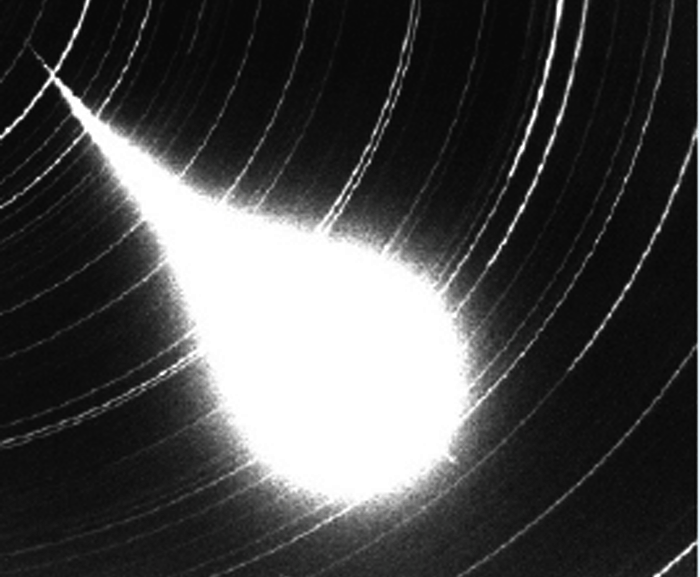
New witness confirms that Rendlesham forest incident was triggered by a fireball
.
Around 3 am on December 26 1980, two security guards near the East Gate at the USAF base at Woodbridge, Suffolk, England, were startled by a brightly lit object apparently descending into nearby Rendlesham Forest. They went off base to investigate, and what they saw – or thought they saw – among the trees sparked off one of the most celebrated UFO events of all times, now generally known as the Rendlesham Forest Incident.
What could this falling object have been? When I began to investigate the Rendlesham case back in 1983, one of the first checks I made was with Dr John Mason of the British Astronomical Association’s meteor section. Their records showed that a bright fireball had burned up over southern England at around 02.50 that morning, the very time that the guards saw what they thought was something falling into the forest.
.
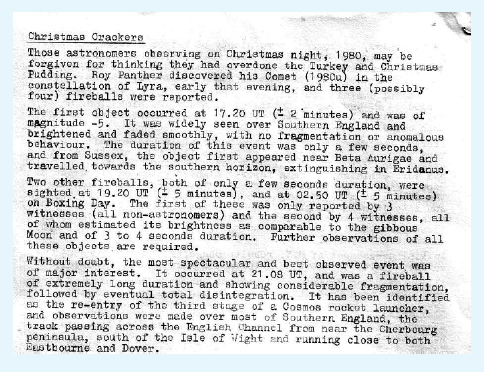
Bright fireballs are a common cause of UFO reports, usually giving the appearance that something has descended to Earth nearby when in fact it has burned up high in the atmosphere. Dr Mason and I have long been of the opinion that this is what the security guards actually saw.
But I was troubled by the fact that there were no confirming sightings from the base. Surely something that bright would have been by someone else in the area? Thanks to a new witness who spoke to Linda Moulton Howe for one of her Earthfiles broadcasts in September 2009, we now have that confirmation.
The witness is Richard Bertolino, a former security guard at Bentwaters, the companion base to Woodbridge. The two bases lay a couple of miles apart, with Bentwaters to the north.
As Bertolino explained on the Earthfiles broadcast, he was on duty on the morning of 1980 December 26 when he and his driver saw what he described as “a very bright falling star. It had a blue-green luminescence, sparkle [sic] tail to it.” He said their immediate feeling was that it was close to them and was “falling between the two bases”.
This is a classic description of a fireball.
Shortly thereafter Bertolino says he heard someone on the radio yelling “There’s a UFO out here!”. In the Earthfiles interview Bertolino estimates the time as about 1 a.m., but it is clear from the talk he heard about UFOs over the radio that what he saw was the 3 a.m. fireball that alarmed the guards at the East Gate of Woodbridge. His testimony leaves little doubt that it was indeed this fireball that sparked off the whole UFO chase in the woods, although Bertolino did not participate in that chase himself.
What the security guards actually saw when they ventured into the forest is another matter. Find out more about the 3 am fireball and the other aspects of the case at my Rendlesham Forest pages.
.
Quelle:Ian Ridpath
.
Ian Ridpath : Introduction and summary
.
THE Rendlesham Forest UFO case has taken on the mantle of the “British Roswell”, but in truth it is a far more significant event than Roswell.
There is scarcely any other UFO case anywhere which can boast such a large number of apparently highly credible witnesses on two separate nights, or such a wide variety of supporting evidence that includes supposed physical traces, an official memo confirming the events written by a high-ranking USAF officer, a real-time tape recording made during the second night of the sighting by the same USAF officer, a report by local police officers who were called to the scene on two separate occasions, and written statements made by the military witnesses to the first night’s events. There are more TV programmes to be found posted on YouTube about this one case than any other, and it regularly appears on lists of ‘best ever’ UFO sightings.
Yet much of the popular discussion of the case has centred not on the well-substantiated primary evidence mentioned above, but instead on various tales of doubtful provenance that emerged many years later once the Rendlesham mythology had become well-entrenched.
I was the first journalist to investigate the Rendlesham incident after it hit the headlines in 1983 and I have been following it ever since. On these pages you can see my BBC TV report about it from October that year and read the first article I wrote about it, published early in 1985. Although old, the article remains valid because it demonstrates where the case stood shortly after it became public knowledge; hence it is a good place for newcomers to begin reading. The article highlights the main elements of the case and offers explanations for each in turn (see the Summary below). Over the years, further evidence has emerged that has strengthened those explanations. The bulk of this website is devoted to examining those explanations and the evidence for them.
My article first appeared in The Guardian, a highbrow English newspaper, on 1985 January 5 under the title “A Flashlight in the Forest”. In this web version I have included a few bracketed asides to clarify and update various points, added some explanations to make various references more comprehensible to non-English readers, and included several illustrations.
The article was written before the release of the tape-recording made by Lt. Colonel Charles Halt describing the events of the second night as he witnessed them. I have placed on this website the latest version of my own transcript of that tape, compiled with the help of Col Halt himself, which corrects many errors contained in various other versions found in print and online. I have also added a detailed analysis of the events on the tape.
Other than Col Halt’s tape recording, the most significant evidence to emerge since my original article appeared was the witness statements made by the participants on the first night of sightings. These statements were unearthed by British researcher James Easton in 1997, whose findings converted him from a believer in the case to an outspoken skeptic. Also of great significance are government documents released since 2001, initially obtained by fellow researcher Dr David Clarke, which confirm that the UK’s Ministry of Defence (MoD) never considered the case worthy of a serious investigation, and we now also know why. In short, there was no cover-up because there was nothing to be covered up.
I hope you will find the contents of this site a suitable balance to some of the more fanciful treatments of this case now in circulation. This remains the only full, rational explanation for the events of those nights back in December 1980.
SUMMARY
Although the overall case is complex, the main aspects can be summarized as follows:
1. Security guards saw bright lights apparently descending into Rendlesham Forest around 3 a.m on 1980 December 26. A bright fireball burned up over southern England at the same time.
2. The guards went out into the forest and saw a flashing light between the trees, which they followed until they realized it was coming from a lighthouse (Orford Ness).
3. After daybreak, indentations in the ground and marks on the trees were found in a clearing. Local police and a forester identified these as rabbit scrapings and cuts made by foresters.
4. Two nights later the deputy base commander, Lt Col Charles Halt, investigated the area. He took radiation readings, which were background levels. He also saw a flashing light in the direction of Orford Ness but was unable to identify it.
5. Col Halt reported seeing starlike objects that twinkled and hovered for hours, like stars. The brightest of these, which at times appeared to send down beams of light, was in the direction of Sirius, the brightest star in the sky.
At its most basic, the case comes down to the misinterpretation of a series of nocturnal lights – a fireball, a lighthouse, and some stars. Such misidentifications are standard fare for UFOlogy. It is only the concatenation of three different stimuli that makes it exceptional. Those unfamiliar with the ways in which nocturnal lights can be misidentified should read my article on astronomical causes of UFOs.
.
The 3 a.m. fireball – how it all started
.
Summary
At the same time that the security patrol at Woodbridge East Gate saw bright lights apparently descend silently into Rendlesham Forest early on 1980 December 26, an exceptionally brilliant meteor, termed a fireball by astronomers, was seen over southern England. It is shown that this fireball is most likely what they saw, and that nothing landed in Rendlesham Forest.
The fireball
British Astronomical Association Meteor Section Newsletter no. 4 dated 1981 February contains a brief report on the fireball that apparently sparked the Rendlesham Forest UFO incident. The BAA report notes that this fireball was seen at 02.50 UT (± 5 minutes) on Boxing Day 1980 by four witnesses, locations not given but seemingly in southern England, all of whom estimated its brightness as comparable to the gibbous (i.e. three-quarter) Moon and of 3 to 4 seconds duration. In that bare information lies the genesis of one of the most celebrated UFO cases of all time.
Brilliant fireballs like this, caused by natural pieces of debris from space burning up in the atmosphere, are a major cause of UFO reports. Although they occur high in the atmosphere they appear to be much lower, and often give the impression that something has plummeted to Earth nearby. They are totally silent. For examples of what such a fireball looks like, see this video, filmed near Perth, Western Australia in 2005 [2.5 MB AVI file] and this one filmed in Sweden in 2009.
Given the coincidence of timing, it seems that the 3 a.m. fireball is what the security guards saw and misinterpreted. (For an example of how a military guard once mistook a bright fireball for a rocket attack, see this page from Tim Printy’s SUNlite newsletter.) So it is important to realize that nothing came down in Rendlesham Forest. Critically, though, the security guards thought that something had come down, so they went out into the forest expecting to find it. Hence they would have been in a state of mind to misinterpret any unknown light.
Did anyone else at Bentwaters or Woodbridge see the 3 a.m. fireball other than the patrol at East Gate? It seems that at least two others did so. The first of these accounts is particularly convincing. It comes from a former security guard at Bentwaters, Richard Bertolino, who was interviewed in 2009 September on a podcast called Earthfiles. To the best of my knowledge, he had never spoken publicly about the case before.
“A very bright falling star”
Bertolino reported that he was on duty on the morning of 1980 December 26 when he and his driver Sergeant Hall saw what he described as “a very bright falling star. It had a blue-green luminescence, sparkle [sic] tail to it.” He said their immediate feeling was that it was close to them and was “falling between the two bases”.
This is a classic description of a fireball. Shortly thereafter Bertolino says he heard someone on the radio yelling “There’s a UFO out here!”. In the interview Bertolino estimates the time as about 1 a.m., but it is clear from the context that what he saw was actually the 3 a.m. fireball seen by the guards at East Gate of Woodbridge. His testimony leaves little doubt that this fireball sparked off the whole UFO chase in the woods. The entire interview with Bertolino can be heard here; his description of the fireball starts at 3 minutes 30 seconds into the podcast.
Later in the same interview Bertolino reports listening to the radio transmissions from Penniston in the forest. His account meshes very well with the witness statements made by the participants, and provides no support for the oft-made claim that significant details were omitted from those statements. Bertolino also recounts that Penniston sketched the object for him in his notebook when they met at the end of their shifts, but makes no mention of being shown any notes or sketches made by Penniston during the event itself. [Note: In his interview, Bertolino wrongly names Steve Longero rather than John Burroughs as one of the three airmen who went into the woods but this is evidently a failure of memory.]
Was Larry Warren a witness?
Another apparent witness of the 3 a.m. fireball, from a location off base, was none other than Larry Warren, whose involvement with events during Col Halt’s expedition to the forest two nights later remains controversial. Unlike much of Warren’s later claims, though, here we have a near-contemporary written statement of what he knew and saw at the time.
On 1981 January 6, a week before Col Halt typed up his now-famous memo, Warren wrote a letter home to his mother, which is reproduced in full in his book with Peter Robbins, Turn Left at East Gate. Warren’s letter starts by referring to the sighting of what is evidently the Cosmos 749 re-entry the previous evening, confirming that the airmen had heard about this through media reports: “Over Europe and England a bunch of lights were seen – Over London one of the lights broke into about twenty smaller lights – and flew in all directions.”
His letter then goes on to report a sighting at 3 a.m. by a security policeman at Bentwaters, and a simultaneous sighting of his own made off-base, both of which seem to coincide with the report by the patrol at Woodbridge’s East Gate of an object apparently descending into the forest.
Below, I have italicized the passages from Larry Warren’s letter that are relevant to the 3 a.m. fireball sighting. As with Bertolino’s testimony, Warren’s hearsay evidence on the activities of Burroughs, Penniston and Cabansag given in the intervening paragraphs is consistent with the statements that these witnesses filed at the time, and again contradicts suggestions that significant details of a close encounter were left out.
“At about three in the morning, a guy I know in D-Flight of Security Police [the same flight at Bentwaters to which Warren was assigned] told me he responded to a falling star outside the Weapons Storage Area...
“Anyway he reported it and then everyone started feeling strange – then a guy on the Backgate at Woodbridge reported a bright light moving through the pine forest. An officer and two sergeants responded but they could not take weapons because they were off base.
“Over the radio they reported seeing a pie-shaped object – about 7 by 8 ft in size. But they said every time they would get near it, it would seem further away all of a sudden. They also said that all the animals in the forest were going nuts.
“Then all of a sudden the light went out – and over the radio they said they didn't like the situation and wanted to go back to base – but they were told to keep on investigating.
“Then they said the thing appeared behind them – it seemed like it was playing games. After 3 and a half miles of following the thing through the countryside and woods – the thing just disappeared in a field. It was only about 10 ft off the ground. This is what a friend of mine said he heard on the radio.
“At that same time, me and five other guys were walking up a dark path about 2 miles from base... cause we couldn't get a ride and we felt like we were being watched and it was strange cause there were no street lights – Then we saw a bright light go right over us about 50 feet up and just fly over a field. It was silent. We first thought it was an A-10 jet. But they scream. So we ran away, because witchcraft and black magic is a big thing in this part of Suffolk and we thought that witches were in the woods. That light just seemed to jump over the trees – Then the next day it turned out that we were in the same place as the U.F.O. so I think we saw it too.” [Ian’s note: In 2008 May Larry told me by email that at the time of the sighting he and his companions were heading back to base from Bromeswell, a village to the west of Bentwaters, and had seen the light in the direction of Woodbridge Base, which was to the south of them, consistent with a fireball over southern England.]
Content last updated: 2013 March.
.
Was the flashing light really the lighthouse?
.
Summary
Of all the questions that need to be answered about the Rendlesham Forest UFO case, the most significant has always been the following: what was the flashing light seen in the forest by the airmen on both nights? This was the first aspect of the case that I addressed once the story appeared in the News of the World in 1983 October, and I was quickly convinced by the suggestion of local forester Vince Thurkettle that it was the Orford Ness lighthouse. Eyewitness evidence that has come to light since then strongly supports this identification. Commonly raised objections to this identification are here examined and found to be invalid.
Visiting the site
Within days of the story breaking, I visited Rendlesham Forest at night with a BBC TV camera crew to interview forester Vince Thurkettle and film the lighthouse flashing as seen from the area where Col Halt, the prime witness, had seen his flashing UFO. However, it was not until many years after my initial visit that I was able to pin down exactly where Col. Halt had been standing. The clue came from an online interview Halt gave to Salley Rayl on the Microsoft Network in 1997 May, by when he had retired from the air force and felt freer to speak. In this interview, the existence of which was brought to my attention by James Easton, Halt noted that the UFO had appeared closely in line with a farmhouse “directly in front of us”.
Armed with this new lead, I returned to Rendlesham Forest in 1998 October. Scouting around at the forest edge, I discovered something that I had not appreciated previously: the top of the lighthouse peeps through a gap between distant trees, and can be seen directly from only a limited area of the forest. Remarkably enough, when I was positioned so that I could see the lighthouse through the gap in the distant tree line, the farmhouse lay right in front of me, in the same line of sight, just as Halt had described it as lining up with the flashing UFO.
Col Halt’s view
The photograph I took on that occasion has been published in various places, but at that time the trees were still in full leaf and the crop in the field had just been harvested, quite different from the situation in the dead of winter when Halt and his men chased their flashing UFO across this field. To get a better idea of what Halt might have seen, I returned to the site on 2005 April 3 in the company of fellow researcher Dave Clarke when there was less foliage around, this time armed with a digital camera, and captured the view below. The upper image is the full-frame view with the lighthouse circled; the lower one is a portion of the same frame enlarged. These photographs demonstrate once and for all that the lighthouse was not “30 degrees off to the right” as Col Halt has since claimed (see next page). He evidently mistook another light for the lighthouse – very likely the Shipwash lightship, which lay in the direction he described.
.
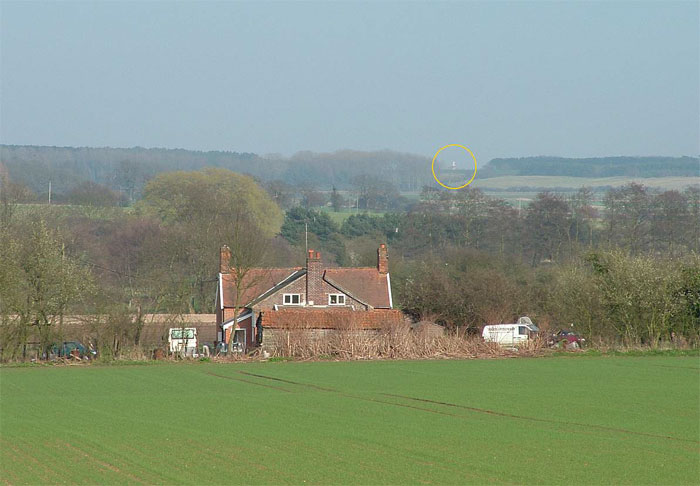
.
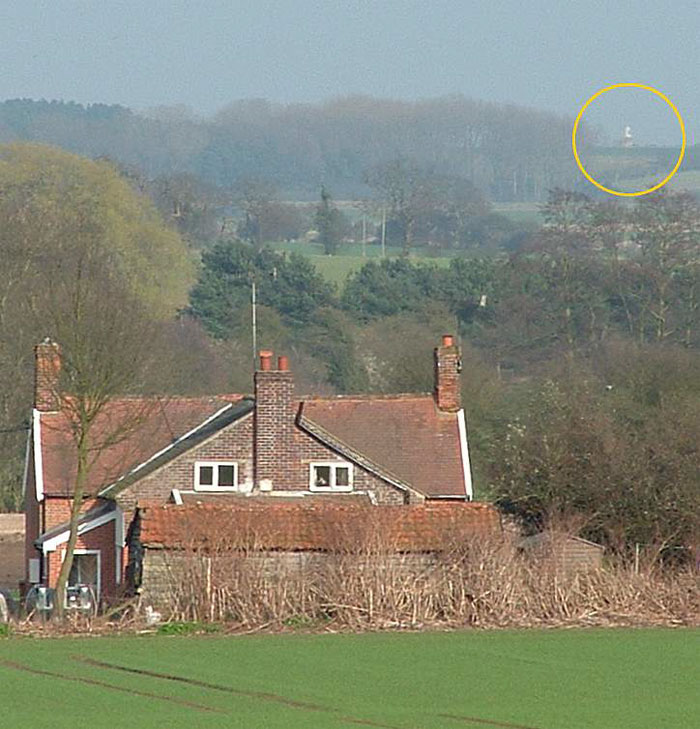
Orford Ness lighthouse seen from the eastern edge of Rendlesham Forest in daylight. I took this photograph in 2005 April from the forest edge, looking east across the neighbouring field towards the lighthouse with the farmhouse in the foreground. I think that it shows us a daylight version of the view that Col. Halt had when he looked from Rendlesham Forest across the field towards the “winking eye” UFO. The tilled soil beyond and to the left of the farmhouse is what I take to be the “second farmer’s field” described by Halt (see below). For a wider-angle view of the field from the same position, click here.
Local resident Tony Nelson of Wickham Market has sent me a super-telephoto view of the top of the lighthouse peeking over the distant ridge, taken by him in December 2006. To see it, and read more about the visibility of the lighthouse.
Looking across the field
The farmhouse in my picture, at Capel Green, is identified in Jenny Randles’ books as Victor Boast’s house. The houses to the north of it (off the left of my pictures), Green Farm, are lower and among trees. The ground falls towards Butley River, two miles to the east. Beyond the river the ground rises again to a fairly flat ridge, with a gap between two stands of trees through which the white top of Orford Ness lighthouse can be seen. Although a shield blocked the beam of the lighthouse from the town of Orford itself, it did not extend far enough to block the beam from this part of the forest, as may be clear from the pictures on this page.
From Halt’s own description that the farmhouse could be seen right in front of them with the flashing UFO almost in line with it, I think I was standing pretty much where Halt and his patrol crossed the fence, which is particularly low and easy to step over at this point. As seen on a recent map of the area, my position was about the middle of the letter G in the name Capel Green. Col Halt confirmed that this was indeed where he crossed into the field in a programme called The UFO Hunters broadcast on the History Channel in 2008 – see this screen grab.
On a photograph of the landing site obtained by researcher Georgina Bruni, daylight is clearly visible between the tree trunks, which would not be possible if the site were more than about 100 metres from the forest edge. This puts its position at around 52° 05’ 20” N, 1° 26’ 57” E. (The Forestry Commission has now put a nice picnic bench about 50 metres north of the spot. WARNING: their “UFO trail” is pure invention!)
Perhaps a better idea of the layout of the area can be gathered from this aerial photograph (click on it for a larger version):
.
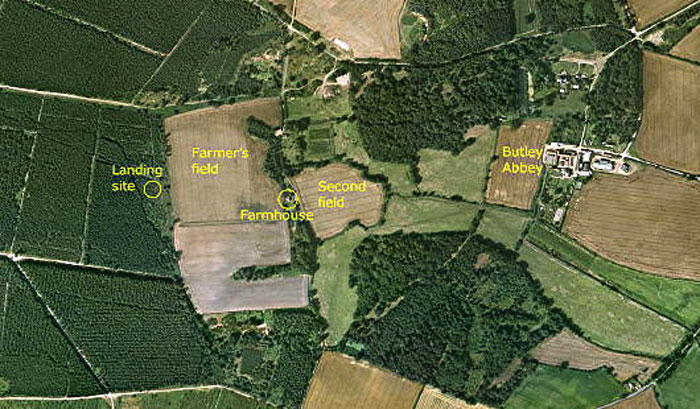
I have labelled the landing site, the farmer’s field and the farmhouse; the Orford Ness lighthouse lies off to the right. After walking across the field and past the farmhouse towards the flashing light, Halt mentioned crossing a second farmer’s field. This would seem to be the next field in line past the farmhouse which I have labelled accordingly. Comparison with the Ordnance Survey map shows this field is bordered by a brook which is apparently the “creek” which Halt, on his tape, reports crossing. (He and his men apparently fell into it, too.)
.
Why did Col Halt not see the flashing light sooner?
This is an intriguing question for which the Orford Ness lighthouse offers a natural answer. Recall that Col. Halt’s men had called him to the scene with the words “The UFO is back”, meaning that they had already seen something out there. But, as we hear from Col Halt’s tape recording, no one pointed out the flashing light to him until he had spent some time at the site. Where had it got to? Had it gone away and come back again, or was it there all the time but hidden?
In my view, the second answer is correct. The Orford Ness lighthouse is directly visible from only a limited area along the forest edge, so anyone just outside this range would not see it – even a few yards makes all the difference.
On this scenario, the landing site that Halt investigated was probably just to the north of the area from which the lighthouse is visible. Only by moving a few paces to the south would the flashing light on Orford Ness be brought into direct view.
Why Col. Halt’s men did not immediately show him the flashing light which they had originally called him out to see is an intriguing question which only they can answer..
RIP the Orfordness lighthouse
At the end of June 2013, the Orfordness lighthouse was turned off permanently. The building is threatened by coastal erosion and will now be allowed to fall into the sea. Hence I have changed all references to it into the past tense.
Could the lighthouse be seen from East Gate?
No it could not. Due to the contours of the land and the intervening trees, the flash from the lighthouse did not become directly visible until you were well into the forest. This helps explain why it came as such a surprise.
It is sometimes argued that the airmen at East Gate would have seen the lighthouse every night and hence could not have mistaken it for a UFO, but this is not true. Their own statements make it clear that they were not familiar with the lighthouse at all.
However, the local police, who were familiar with the lighthouse, were of the opinion that it was the light that had been seen – see the comment from Inspector Mike Topliss of Suffolk constabulary near the bottom of this page.
As Topliss noted, under certain atmospheric conditions the loom of the lighthouse beam could be seen over the trees or could reflect off low cloud, causing odd visual effects. It is possible that these effects added to the overall strangeness of the sighting.
The height of the light is just right!
According to this Trinity House information page, the Orfordness light (they spell it as one word) was 28m above mean high water. Hence it was easily visible above the intervening ridge, which has a maximum height of 19m (OS spot height) in this region.
The position at the forest edge from which I took these photographs at left is between the 20-m and 15-m contour lines on OS maps. Anyone standing here is close to the same level as the lighthouse beam, and so it would have shone directly into their eyes. A good analogy might be the headlights of aircraft, which look intensely bright when aimed in your direction but soon fade as the aircraft turns.
You can read more about the visibility of the lighthouse here.
How bright was the light?
At the time of the Rendlesham Forest UFO incident, the Orfordness lighthouse was one of the brightest in the country with an intensity of 5 million candelas, according to official Trinity House figures. Only St Catherine’s on the Isle of Wight (5.25 million cd) and Strumble Head in Pembrokeshire (6 million) were brighter in England and Wales.
Subsequently, the bulb in the lighthouse was changed twice, and the appearance of the beam changed along with it.
At the time of the UFO sighting in 1980 the lighthouse was fitted with a 3-kilowatt 100-volt filament lamp. That was replaced in 1991 with a 1 kW 240V mercury vapour discharge lamp. The final bulb, installed in 2000, was a 70-watt 12 volt metal halide lamp which ran off batteries. According to the Trinity House website, its intensity was 635,000 candelas, only about 13% of the value in 1980. Hence many visitors to the site never saw the full effect of the light as it appeared at the time of the UFO sighting.
The old bulbs from the lighthouse are kept on display in the bar of the Jolly Sailor pub in Orford.
Another complicating factor when comparing the later appearance of the light with 1980 is that the visibility of any distant light is strongly affected by atmospheric conditions. Anyone visiting the site on a night of low atmospheric transparency would not have seen the full intensity of the Orford light. Fortunately my early visits were all on clear nights, when I could appreciate how bright the beam appeared. Indeed, it looked to be no more than a couple of hundred yards away between the trees, much as reported by the original witnesses.
Scattering in the atmosphere causes reddening of a light (see Optical phenomena and optical illusions near lighthouses by C. Floor). The final metal halide bulb was not only much weaker but whiter than the old incandescent bulb in use in 1980. Even so, it could still appear yellow or even orange depending on conditions, as film maker Adrian Frearson demonstrated in 2008.
.
What were the other lights seen by Col Halt?
.
As well as the flashing light near ground level that was seen to the east, Col. Halt’s memo on the Rendlesham Forest sightings reported three starlike objects in the sky at about 10 degrees altitude, one in the south and two others in the north. The one in the south, which was the most prominent, was visible for two or three hours and was reported to beam down a stream of light from time to time. Some UFO researchers have failed to distinguish the fact that these starlike objects were quite different from the original flashing light to the east and have treated them as though they were all caused by the same highly mobile object. Here it is shown that these starlike lights have a completely separate explanation.
Identifying the lights
In my original investigation, I tentatively identified these three starlike objects as real stars: first-magnitude Deneb and Vega in the north, and Sirius, the brightest star in the sky, in the south. I reached my conclusion before Col. Halt’s tape recording of events was released. That tape contains additional information about the positions of these objects which allows us to make a more secure identification.
On the tape, Halt describes the starlike object to the south as “hovering over Woodbridge base at about five to ten degrees off the horizon” at 4 am. However, no one at Woodbridge seems to
Halt’s superior officer, Col Ted Conrad, came out of his house at Woodbridge but failed to see any of the strange lights described by Halt.
have seen this object supposedly hovering above them even though they went out and looked. Halt’s superior officer, Col Ted Conrad, was monitoring events by radio and came out of his house at Woodbridge along with his wife and several others. But, as he told researcher David Clarke, they failed to see any of the strange lights described by Halt either in the sky or on the ground.
We do not know exactly where Col. Halt was when he taped that 4 am note, but from his patrol’s likely position either in the forest or on their way back to Bentwaters the base buildings at Woodbridge would not in fact have been due south of them but southwest. A simple planetarium computer program shows that this is indeed where Sirius was slowly setting, being at an altitude of about 7 degrees when Halt taped his note at 4 am. If Halt’s definition of north was similarly skewed, this supports the identification of Deneb and Vega, which were actually east of north.
Moving and beaming
Some researchers have been unconvinced by these prosaic identifications, citing Halt’s taped description of the objects as "dancing about with coloured lights on them" (in his memo he had said they “moved rapidly in sharp, angular movements and displayed red, green and blue lights”). But of course stars twinkle many colours as their light is refracted by the atmosphere, and the effect is most noticeable when they are near the horizon, as they were in this instance. In another common effect, stars appear to move from side to side due to movements in the observer’s eye (the so-called autokinetic effect). When they are seen between scudding cloud they can appear to be moving when it is actually the cloud that is moving.
Another of Halt’s descriptions, contained on tape and in his memo, is that the objects appeared as ‘half-moons turning to full circles’ seen through an 8–12 power lens (presumably zoom binoculars or a monocular), but this was evidently an optical effect as he attempted to focus the binoculars.
More puzzling, perhaps, is this quotation from Halt’s tape: “Here he comes from the south. He’s coming toward us now. Now we’re observing what appears to be a beam coming down to the ground”. (On the tape, Halt’s description of these beams is much less exciting than he has made them sound in subsequent interviews.)
Of course, the brilliance of objects such as Sirius causes dazzle in the eye which can give the impression of beams (as with the ‘fiery cross’ effect of Venus). But what could cause stars apparently to move towards or away from the observer? The answer is obscuration by thin, moving cloud. The resulting changes in the brightness of a star can give the false impression of approach (brightening) or recession (dimming). The length of time for which the starlike objects were viewed (several hours) reinforces the belief that they were in fact stars.
To me, the descriptions attributed to the “starlike objects” sound like the standard misperceptions of celestial objects which feature in so many other UFO reports. (For more on the ways in which celestial objects are misperceived, see my article on the astronomical causes of UFOs.)
Halt’s reaction
What did Halt do about these unidentified lights supposedly gallivanting in his airspace? As he told journalist Salley Rayl in an interview published in the 1994 April issue of Omni: “I called the
“After an hour or so, I finally made the call to go in.
We left those things out there.”
command post, asked them to call Eastern Radar [i.e. RAF Watton], responsible for air defense of that sector. Twice they reported that they didn't see anything.” (British researcher Nick Redfern had previously found that Eastern Radar had logged a call from Halt at 3.25 a.m. on December 28.)
After that there was not much more to do. Near the end of his tape, Halt says: “03:30 and the objects are still in the sky, although the one to the south looks like it’s losing a little bit of altitude. We’re turning around and heading back toward the base.”
Halt confirmed this in his interview with Salley Rayl: “After an hour or so, I finally made the call to go in. We left those things out there.”
What a curiously unsatisfactory way to end a supposed close encounter – “We left those things out there.”
British investigator Jenny Randles adds another telling quote on pp. 123–4 of her book UFO Crash Landing (1998). She says Halt told her that when he was back at base, “the objects were still in the sky – however, it was getting light and they were getting faint”. Jenny adds: “I suspect that this is the final clue that demonstrates that these star-like lights to the north were, indeed, just stars.”
Other witnesses
More recently, Halt has confused the issue by claiming that there were three objects in the sky to the north, not two, and that they sent down beams into the Weapons Storage Area (WSA) at Bentwaters. However, security policeman Tim Egercic, who was actually in the Bentwaters WSA at the time, has publicly refuted Halt’s claim that any such beams came down into the WSA. In fact, on the tape and in the memo the only object Halt describes as sending down beams is the one to the south, over Woodbridge, not the ones to the north, over Bentwaters. So this more recent claim by Halt seems to be based on faulty memory.
Another witness at Bentwaters, Rick Bobo, has spoken about seeing lights in the sky that night from the watchtower in the Bentwaters WSA. He told author Robert Hastings:
“The main object hovered out there for a long, long time [he had previously told Georgina Bruni “it was up there for about five hours, just hovering”]. It never really moved anywhere else. It was kind of hard to see, but it was slightly oblong, I guess, and I seem to recall it had bluish and reddish lights on it. When the object first caught my eye, it was already stationary, I didn’t see it move to where it was and I didn’t see it leave. After it was hanging there a long while, I saw things shooting off it, really, really fast, like little sparks or something. Maybe four or five of them... They were shooting off in all directions, but up into the sky, not down to the ground.”
Bobo’s account has all the hallmarks of a misidentification of twinkling stars, as outlined above. If this sounds implausible, think how less likely it is that a large, brightly lit alien craft should hover for hours over Suffolk without attracting wider attention.
All eyewitness reports of the lights in the sky, including Halt’s, describe them as hovering low over the forest. No one ever claimed to see them high up. From Bentwaters they were seen towards the south, so they cannot have been the same objects that Halt saw to the north and which he claimed were over the WSA at Bentwaters. In summary, all the sightings of lights hovering in the sky are consistent with bright stars seen twinkling close to the horizon.
Last updated: 2014 February
.
Were the radiation readings significant?
.
Summary
According to the manufacturers of the instrument that was used to take radiation readings in Rendlesham Forest in December 1980, the measurements were “of little or no significance”. From the evidence of the real-time tape recording made during the investigation, it is shown that the readings are simply background levels and do not support the claim that anything unusual happened in Rendlesham Forest. Onsite checks made within a few years of the incident revealed no unusual radiation at the site.
Setting out the case
In his book Open Skies, Closed Minds, Nick Pope described the radiation readings taken by Col. Halt’s team at the supposed UFO landing site in Rendlesham Forest as “the most tangible proof that something extraordinary happened there”. To justify such a claim, it is essential that the readings are shown to be beyond reproach.
My original conclusion, based on telephone discussions with the UK’s National Radiological Protection Board (NRPB), was that the figures reported in paragraph 2 of Col. Halt’s memo, from
Halt’s peak measurement of the radiation at the site was the bottom reading on the lowest range of the monitor
0.05 to 0.1 milliroentgens, were simply background levels of radiation. (As a technical aside, the correct units should have been milliroentgens per hour – the use of incorrect units seems to betray an unfamiliarity with radiation monitoring).
The subsequent release of Col. Halt’s real-time tape recording of events confirmed that the peak figure obtained was simply a random burst, not a steady level. For much of the time scarcely anything was being picked up by the geiger counter. On the tape we hear them describing the readings at the site as “minor clicks” and “three to four units”, i.e. 0.03 to 0.04 mR/h. They got these readings as they approached the site and then as they checked each of the supposed landing marks. Confirmation that this was only background radiation comes from the fact that the same levels were also recorded over half a mile away from the supposed landing site, after they had crossed two fields beyond the forest (read the transcript here).
The highest reading mentioned on the tape is “seven tenths”, i.e. 0.07 mR/h; this was a ‘spike’ obtained briefly at the centre of the site, not a steady level. In his memo, Halt reports a peak figure of 0.1 but we do not know where that was obtained, or whether it was just a rough value recalled from memory. The figure of 0.07 mentioned on the tape is only twice the general reading. Such a random jump could easily have been caused by natural sources, or even an accidental movement of the meter, and hence is not significant.
Yet, as is clear from Nick Pope’s quotation above, my conclusion has not been universally accepted. Pope’s own researches led him to claim that the radiation levels recorded were 10 times higher than normal, and similar claims have been made by others.
Resolving the issue
Thanks to the influence and contacts of the British physicist Professor Frank Close the matter was resolved more definitively in 1997 for a television discussion programme produced by London Weekend Television (called Strange But True – Live) on which Professor Close and I were to appear along with Nick Pope and Col. Halt.
My earlier inquiries had shown that the radiation monitor used by Halt and his team would have been of the type known as an AN/PDR-27. On behalf of Frank Close, NRPB contacted the American manufacturers of the AN/PDR-27, who stated that Halt’s peak measurement of 0.1 mR/h was the “bottom reading on the lowest range” of the monitor and was “of little or no significance”. They noted further that these instruments are designed to be used to monitor workplace fields or radiation levels after sizable nuclear incidents and are therefore not suitable for environmental monitoring at background levels. On the basis of this information from the manufacturers, NRPB concluded that using such an instrument to establish a level of 10 times background is not credible.
.
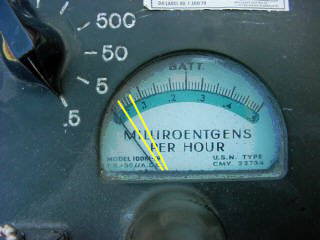
An AN/PDR-27 meter of the type used by Halt et al, shown switched to its lowest range, which Halt referred to on his tape recording as the “Point Five scale”. The dial has five major divisions from 0.1 to 0.5 and each of these is subdivided into tenths. All the readings obtained were below 0.1 milliroentgens per hour, i.e. below the first major division on the scale. Mouseover the image to see the 0.03 and 0.07 levels marked.
.
This, therefore, is the official view of NRPB and of the makers of the radiation monitor, which Frank Close publicly demonstrated to Nick Pope and millions of viewers on live TV on 1997 June 27. To confirm the matter I subsequently wrote to NRPB to ensure that there was no misunderstanding. In a letter to me dated 1997 July 7 Michael Clark of the NRPB stated: “We are convinced of the correctness of our interpretation.”
Nick Pope’s ‘investigation’
Nick Pope, however, had contacted not the NRPB but the Radiation Protection Services department of the UK government’s Defence Evaluation and Research Agency (DERA). Pope has described his inquiries as “the first and only official investigation into this aspect of the case”. [Now that the official Ministry of Defence file on the case has been released, we can see for ourselves the results of this “official investigation” – a handwritten memo amounting to fewer than 150 words.]
In his book, Nick does not say who it was that he spoke to at DERA Radiation Protection Services, but it was actually a man named Giles Cowling. When I tracked Cowling down, via his colleague Ron Brown, they sounded surprised that their opinion had been published in Nick’s book. Rather than regarding it as an ‘official investigation’ Cowling described his discussions with Nick Pope as a ‘private conversation’. Perhaps this is why Pope did not name his source or quote him directly.
When I presented Cowling with the above information from the NRPB, he wrote to me as follows on 1998 August 21:
“In my original discussions with Mr Pope I did indeed state that the readings were around 10 times normal background levels, provided that the instrument was appropriate for measuring background radiation (at the time of our discussions he could not state what the instrument was), calibrated and being used/interpreted correctly. I share the NRPB view that the use of a high-range survey instruments to measure (accurately) environmental levels of radiation is somewhat questionable and this must throw some doubt on the validity of the data reported.”
Cowling also confirmed to me by telephone in 1998 August that Nick Pope had not re-checked the facts with him. This was over a year after Professor Close’s TV demonstration that there was nothing significant about the radiation levels at Rendlesham – an opinion with which Cowling, Pope’s own source, now agrees. (See also 2009 Update, below.)
Tim Printy, a former US Navy nuclear engineer familiar with the AN/PDR-27, has made an independent assessment of the radiation readings at Rendlesham, concluding that “contrary to what Nick Pope has stated, the levels reported are insignificant even if the maximum reading of 0.07 mR/h was accurate” – for full details, see this page from Tim’s online UFO review SUNlite.
Some on-site checks
In September 1982, less than two years after the event, the site was checked for radiation by researchers from the Swindon Centre for UFO Research and Investigation (SCUFORI). They found nothing unusual. Nor did USAF Major James McGaha when he checked the site unofficially in 1987 while stationed at the base. McGaha emailed me in 1994: “There [was] nothing above background. They simply did not know what they were doing. If there were higher levels then you would still see them today, even with a very careful clean-up.”
In 2003, as part of a TV documentary about the Rendlesham case, the Sci Fi Channel made their own check on radiation levels at the site in the hope that, had the area genuinely been contaminated with unusually high levels of radiation, some traces might remain. (Of course, it has never been established why an alien craft should be leaking radiation, or what sort of radiation was involved*.) The readings were taken for them by Patrick Davison, an environmental scientist from Mayer Environmental Ltd of Brentford, west London. The Sci Fi Channel’s programme itself was non-commital about the results, but Davison confirmed to me by telephone in 2006 March that he found nothing above background at the site.
CONCLUSION: If Nick Pope or anyone else is going to continue to use the radiation readings as “tangible proof that something extraordinary happened there” then they are on very shaky ground indeed.
.
2009 update – Pope tries again
In a pro-UFO TV programme first broadcast in 2009 called I Know What I Saw, Nick Pope was interviewed about the radiation readings at Rendlesham. In this interview, Pope did not rely on his now-discredited ‘investigation’ discussed above but showed instead this internal memo from the Ministry of Defence files which says in part: “The value of 0.1 milliroentgens (mr) ... seems significantly higher than the average background of about 0.015 mr.” In the TV interview, a clip of which can be seen here, Pope described the memo as “One of the most important documents to emerge from the MoD’s case files... absolute proof positive that something extraordinary happened”.
The MoD files make it clear that they never undertook any investigation into the radiation levels at Rendlesham so they never established the truth about the readings reported by Halt. The opinion in the MoD memo was based on the same assumptions as Pope’s own cursory ‘investigation’, namely that the figure quoted by Halt was a steady level and taken with an appropriate instrument. As we have seen, both these assumptions are incorrect – it was a random peak recorded by a meter designed to measure much higher levels of radiation. Hence the opinion quoted by Pope is no ‘proof’ at all and would doubtless have been withdrawn had the MoD established the full facts laid out above.
* Many current spacecraft use radioisotope thermoelectric generators (RTGs) to generate electricity. These use fuel with a half life of many decades, usually plutonium 238. Any spillage from such a device should still be detectable today. Nuclear reactors of the type used in terrestrial power stations use fuel with a half life of thousands of years, and radiation due to a leakage from such a reactor would still be easily detectable far into the future.
.
What were the landing marks?
.
Summary
Following the first sighting of a flashing UFO in Rendlesham Forest, a triangle of small indentations was located between the trees near the eastern edge of the forest, and was attributed to the UFO. Evidence is presented that these depressions did not form a symmetrical triangle and were indistinguishable from rabbit diggings.
Physical traces?
As a close second to the radiation readings, the most celebrated physical traces at the Rendlesham Forest UFO landing site were the supposed landing marks, consisting of a triangle of indentations in the forest floor. Both Vince Thurkettle, a local forester, and the local police who saw them were convinced these were nothing more than rabbit diggings, and not new ones either. A trip to Rendlesham or any similar forest will turn up endless examples of such marks. The question inevitably arises: how can anyone distinguish between indentations made by an animal and those made by a landed UFO?
In his memo to the UK’s Ministry of Defence, Col. Halt said: “Three depressions 1.5 inches deep and 7 inches in diameter were found where the object had been sighted on the ground.” It is not clear how the airmen knew exactly where the object had been on the ground. Apparently they did not mark the site at the time but went back later to look for signs of a disturbance that could be attributable to the supposed craft.
Photographs of the marks
.
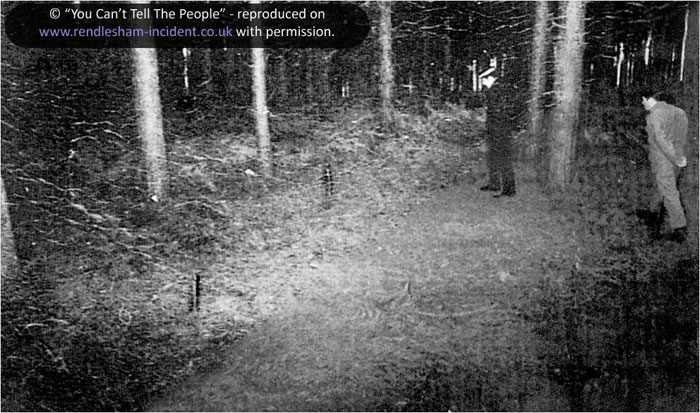
This photograph, taken by Master Sergeant Ray Gulyas and unearthed by researcher Georgina Bruni, shows PC Brian Cresswell of Suffolk Police examining a triangle of marks with Capt. Mike Verrano in Rendlesham Forest after daybreak on the morning of 1980 December 26, just hours after the famous UFO encounter by Jim Penniston, John Burroughs and Ed Cabansag. The three marks had been interpreted as landing marks and each was identified with a stick on its outside. The rightmost stick is difficult to see but is in fact next to Verrano’s leg; a smaller mark near the centre of the picture is sometimes wrongly identified as one of the landing marks. North is to the left.
The triangle is approximately 3 metres across at its widest. It is difficult to imagine how something this large could have manoeuvred between the trees as is claimed. Of course, we cannot tell from this photograph whether these were the only three such marks in this area or whether there were others that were ignored because they did not fit with the big triangle.
Daylight visible between the trees in the background confirms that this site was within a hundred yards or so of the eastern forest edge (for an aerial map of the location, see here). This is the site that was investigated by the deputy base commander, Col Charles Halt, two nights later when the UFO was seen again.
.
There are conflicting reports about who found the landing site, but John Burroughs told me by email on 2008 January 17 that he thinks it was Captain Mike Verrano and Master Sergeant Ray Gulyas. Gulyas took this photograph (left), unearthed by researcher Georgina Bruni, which shows PC Brian Cresswell examining a triangle of marks with Capt. Verrano on the morning of 1980 December 26. Each of the marks was identified with a stick – click on the picture for an enlargement. Daylight visible between the background trees confirms that this site was indeed near the forest edge. Plaster casts were taken by Penniston of the impressions and have occasionally been displayed at UFO conventions and on TV.
Close-ups of individual marks are shown on other photographs taken by Gulyas that same morning and obtained by Georgina Bruni. These were forwarded by Lord Hill-Norton in 2001 to the Ministry of Defence, which released them publicly in 2007 under the Freedom of Information Act; two examples are shown below. They appear to be nothing more than shallow disturbances in the layer of pine needles that carpets the forest floor. The small sticks next to them were pushed into the ground by USAF personnel as position markers. Vince Thurkettle has confirmed to me that he believes these pictures are of the same landing site he was shown, at the eastern edge of the forest. Halt has taken TV crews to this same area. Incidentally, some witnesses have described seeing imprints that looked like they were made by a catering-sized coffee can. It is possible that these were made by the airmen to indicate the position of the landing site, but were later mistaken by others as the ‘real’ marks.
.
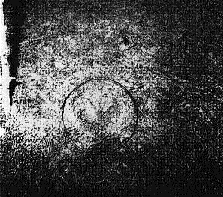
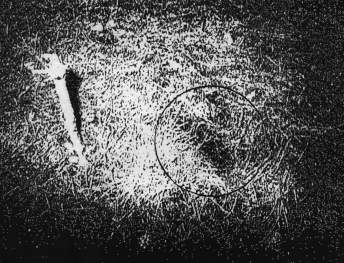
Photographs of two of the so-called landing marks in the forest floor. Each has a stick next to it placed by the airmen who found them. Click on a picture for an enlargement. Similar marks dug by animals can be widely seen on the forest floor. It is sometimes said that the ground was ‘frozen solid’, but this is sandy soil overlain with pine needles and does not freeze.
.
Col. Halt’s description
To get a better understanding of what these marks were like, we should start with Col. Halt’s own reaction when he saw them for the first time, as contained on his tape. They cannot have been at all obvious, for he had to ask: “Where are the impressions? Is that all the bigger they are?”
This spontaneous comment reveals his disappointment. Evidently his rather garbled second sentence is a concatenation of the reactions “Is that all?” and “Aren’t they any bigger than that?” Indeed, from the dimensions he gives in his memo they are about the size of a hand and the depth of a thumb – suspiciously similar in size to rabbit diggings, and surely too small for the presumed landing gear of an object described by some witnesses as being “as big as a tank”. In a talk to a UFO group called Quest International at Leeds, England, in July 1994, Col Halt said that the marks looked as though they were made by legs sticking out at an angle. He might have added that burrowing animals dig in at an angle, too.
The forester’s sketch
Vince Thurkettle was shown the site in early February 1981, about 6 weeks after the supposed landing. Click here for a TV interview in which he explains his reactions on seeing the marks and how he knew what they were.
.
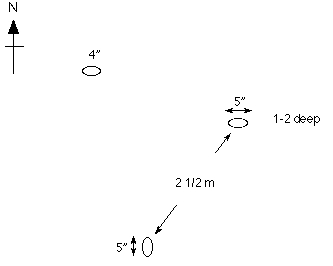
Vince sketched the marks at the time; I
have redrawn his sketch at left for clarity. A number of comments are necessary. Firstly, Vince used a mixture of units on his sketch – the size of the indentations is given in inches but the separation between them is written as two and a half metres. (This matches the dimensions of the triangular object reported in Halt’s memo, which was said to be “two to three metres across the base”.) No units are given for the depth, simply written as ‘1–2’, but presumably Vince means inches here also. On his original sketch the distance between the two left-hand indentations is slightly greater than that of the other two sides of the triangle, which accords with his statement to me many years ago that the three marks did not form a symmetrical triangle.
The most notable fact about the indentations drawn by Vince is that they are markedly oval in shape, and the southerly one is oriented almost at right angles to the other two. The northernmost of the three indentations is labelled as only 4 inches long, against 5 inches for the others. (This is somewhat smaller than the figure in Halt’s memo of 7 inches diameter, although the depths are the same.)
It is sometimes claimed that Vince was not shown the ‘real’ landing marks but a different set some distance away. This is an easy way of dismissing awkward evidence, but in turn raises the question: how many similar sets of marks were there in that forest?
Either way, one is left wondering what sort of advanced craft totters around the Galaxy on a tripod with small, splayed feet like those described by Col Halt.
.
...and what about the tree damage?
A related aspect concerns supposed tree damage above the landing site. Jenny Randles has laid great emphasis on this and, on page 183 of her book UFO Crash Landing, she claims it is one of the “vital clues” to the case.
In that book she quotes a forester she names as James Brownlea, “one of the team from the little wooden headquarters in what is known locally as Tangham Wood” (UFO Crash Landing, page 66). According to her, Brownlea said: “I noticed that the pine trees well above the ground were broken as if something heavy had fallen through from the sky. Branches were also torn off lower down. There were signs of scorching and burning on the forest floor and a series of indentations which indicated that something solid had come down there. There was also evidence that an object may even have been dragged along the ground to remove it from the area.”
However, it is not clear from the book whether she actually spoke to him herself or whether the information came from Brenda Butler. I asked Jenny about this recently and she told me: “After all these years I am not 100% certain. I spoke with several foresters (Vince Thurkettle was especially helpful). But I suspect that the story came second-hand from Brenda and I may have met Brownlea at the forestry offices later. I certainly never did a formal interview with him.”
I asked Vince Thurkettle about James Brownlea, and he replied:
“There neither was nor is any Forestry Commission forester by that name and there was nobody working in the forest that I can recall of that name. If he is a real person, using his real name, he either worked on contract (though I don’t recall us having any work out to contract at that time) or he worked for one of the local estates.”
As for the damage that the mysterious Mr Brownlea described, Vince noted that he and his fellow foresters could not have missed it: “Broken off trees and burning would have stood out somewhat amongst the healthy trees.”
So much for ‘evidence’ which, Jenny says in her book, “has never been successfully tackled by any of the skeptics”.
Content last updated: 2012 April
.
Where was the “landing site” that Halt investigated?
.
Summary
The location of the supposed ‘landing site’ of the Rendlesham Forest UFO is determined, where a triangle of marks was discovered in the forest floor that was attributed to the UFO. Separate lines of evidence confirm that the marks were indistinguishable from rabbit diggings and there was no unusual radiation at the site.
Locating the site
Below is an aerial view identifying the position of the supposed UFO “landing site” at the eastern edge of Rendlesham Forest that Col. Halt investigated in the early hours of 1980 December 28. This position has been derived from statements made by Halt in various interviews, and is supported by the testimony of forester Vince Thurkettle who saw the site some time after the event. Its coordinates are close to 52° 05’ 20” N, 1° 26’ 57” E and is about a mile east of Woodbridge East Gate. A photograph of the site taken the morning after the initial sighting, when it was being examined by local police, can be seen here.
Col Halt chases the UFO
While examining the site, which consisted of three small indentations on the ground and apparent burn marks on the nearby trees, Halt’s men drew his attention to a flashing light betweeen the trees, and they moved to the edge of the forest to get a better view. Halt described looking across a field towards a farmhouse, with the flashing light almost in line with it. In an attempt to get closer to the light, he and his men moved out into the field past the farmhouse and then through another field and across a stream. (Read a transcript of what he said on the tape.)
I have labelled all these locations on the image below, along with Butley Abbey which is the group of buildings at right of the picture. Click on the image for an enlargement. You can also see the region on Google Maps.
.
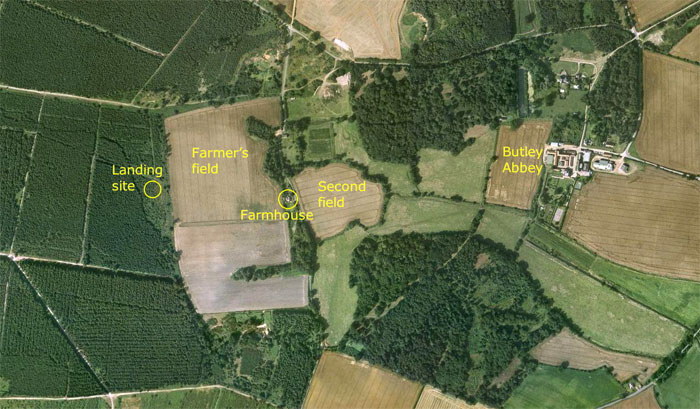
Col Halt confirms the location
There has in the past been some confusion among other researchers about Halt’s exact position at the time of his sighting, with various books and web sites offering conflicting locations. However, Halt put any uncertainty to rest when he retraced his steps for a programme called The UFO Hunters broadcast on the History Channel in 2008. He took them to the spot where he and his men (the cut-out “soldiers” in the illustration below) crossed into the field in pursuit of the elusive UFO. Thus Halt confirms in his own words that he was indeed within the area from which the lighthouse beam can be seen directly. The witnesses on the first night also saw a flashing light in the same direction from the same spot (see their route into the forest here).
This graphic is a screen grab from The UFO Hunters programme (the capital H at bottom right is the History Channel logo):
.
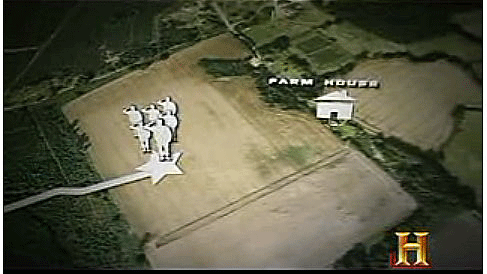
Unfortunately, the programme makers took Halt at his word when he said the lighthouse was 30 degrees off to the right of the farmhouse. As any map will show, it isn’t!
.
Was the Rendlesham Forest sighting due to a prank that got out of hand?
.
In the summer of 2003 a former USAF military policeman at Woodbridge, Kevin Conde, claimed on television and in the press that the Rendlesham Forest UFO case was sparked by a practical joke he staged in his police car t
5365 Views
